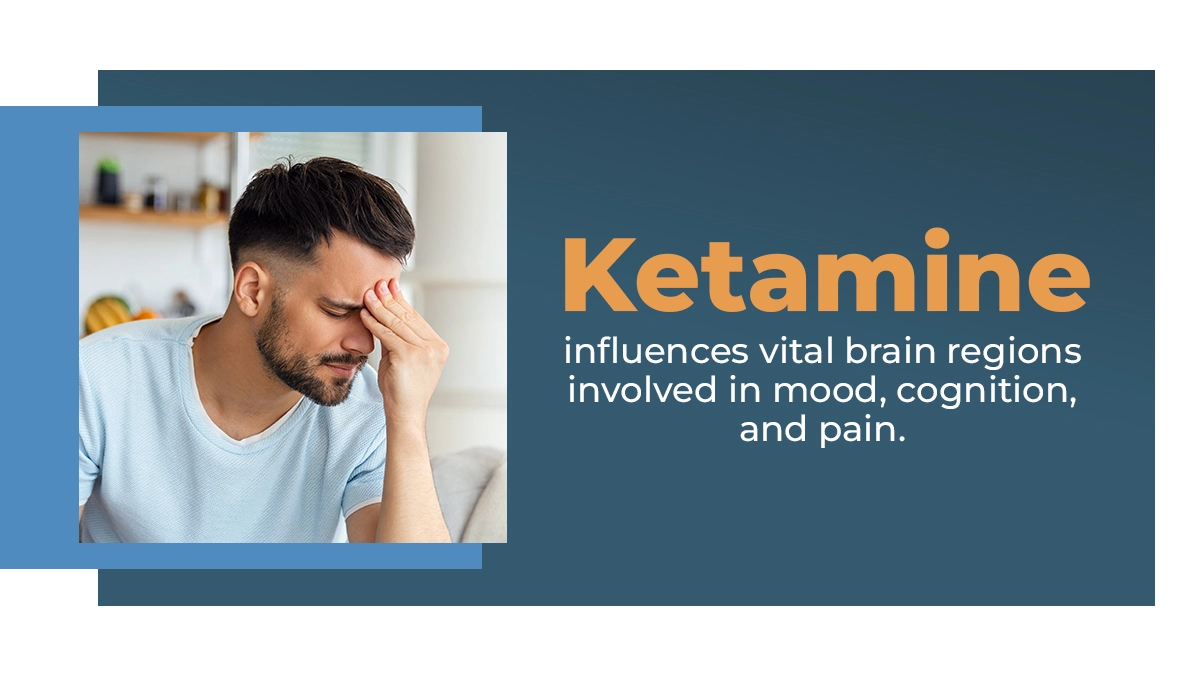
Effectiveness Of Medication-Assisted Treatment
Explore the effectiveness of medication-assisted treatment with The Recovery Team-Newton.

Ketamine is a medication that affects the brain in distinct ways. It primarily interacts with neurotransmitters, chemicals that help transmit signals in the brain. By influencing the N-methyl-D-aspartate (NMDA) receptor, ketamine alters how the brain processes information. Its effect can lead to changes in mood, perception, and cognition.
Additionally, ketamine has been found to impact the brain’s connectivity, which can contribute to its therapeutic benefits in certain conditions. This article will explore how ketamine modifies brain function, the underlying mechanisms of these effects, and its potential applications in mental health treatment.
Ketamine primarily targets N-methyl-D-aspartate (NMDA) receptors to increase glutamate, impacting brain function and mood regulation. Here’s what you need to know:
The Recovery Team-Newton offers comprehensive, personalized support for individuals seeking wellness. Call us at (508) 978-2772 for more information.
Ketamine, synthesized in 1962 and approved as an anesthetic in 1970, is a versatile medication with significant brain impacts. Initially used in veterinary medicine, it was accepted for human use due to its safety profile.
Ketamine causes dissociative anesthesia, offering pain relief without complete consciousness loss. Its unique properties make it valuable in emergency medicine and psychiatric treatments. Over time, it has been extensively studied for various medical and psychiatric applications.

Ketamine is a multifaceted drug with medical and recreational applications. Classified as a dissociative anesthetic, it provides sedation, pain relief, and memory loss while maintaining cardiovascular stability. Its chemical structure allows it to interact with multiple brain receptors.
Available in injectable and nasal spray forms, ketamine is widely used in emergency medicine due to its rapid onset and safety profile. It is effective in both medical and psychiatric contexts, making it a versatile option for treatment.
Ketamine was first used in the 1960s as an alternative to phencyclidine (PCP). Its safety and efficacy led to its adoption in battlefield medicine during the Vietnam War. It provided reliable anesthesia with fewer side effects than other agents.
Over the decades, it became a staple in emergency and veterinary medicine. Its off-label use in treating depression emerged in the early 2000s. Historical usage patterns highlight its versatility and evolving applications.
Medically, ketamine is used for anesthesia, pain management, and psychiatric treatment. It is effective in treating treatment-resistant depression and chronic pain.
Recreationally, it is known for its dissociative and hallucinogenic effects. It has led to concerns about misuse and dependence. Regulations aim to balance medical benefits with the potential for recreational abuse.
Ketamine’s effects on the brain involve complex interactions with neurotransmitters and brain regions. This section delves into these mechanisms.
Ketamine primarily affects the neurotransmitter system. It blocks N-methyl-D-aspartate (NMDA) receptors involved in pain transmission and mood regulation. This blockade increases glutamate levels, leading to altered brain function.
Glutamate is the most abundant excitatory neurotransmitter in the brain. Changes in glutamate activity are linked to ketamine’s antidepressant effects. This interaction underpins many of its therapeutic benefits.
Ketamine influences vital brain regions involved in mood, cognition, and pain. The prefrontal cortex boosts activity and connectivity, which supports mood regulation and decision-making, which is crucial for treating depression. Enhanced prefrontal cortex function underlies its rapid antidepressant effects.
Ketamine also affects the hippocampus, which is vital for memory and learning, by increasing synaptic plasticity and connectivity. These changes are linked to improved cognitive function and mood.
The hippocampus’s role in neurogenesis further supports ketamine’s long-term benefits. Together, these effects on the prefrontal cortex and hippocampus contribute to ketamine’s therapeutic and psychoactive properties.
Ketamine’s short-term effects include anesthesia, dissociation, and cognitive changes. This section explores these immediate impacts.
Ketamine induces anesthesia and sedation rapidly. It provides pain relief without complete loss of consciousness. It makes it valuable in emergency and surgical settings.
The sedative effects help manage acute pain and distress. Ketamine’s versatile properties make it an anesthetic agent. It achieves anesthesia through N-methyl-D-aspartate (NMDA) receptor antagonism.
Ketamine causes dissociative effects, altering sensory perception and consciousness. These changes include a sense of detachment from the body. Sensory perception changes can be profound, affecting vision and hearing.
Hallucinations are common, varying in intensity and nature. These effects can be disorienting but are typically short-lived. Dissociation is a hallmark of ketamine’s psychoactive profile.
Ketamine temporarily impairs cognitive and motor functions. These effects include difficulty with memory, attention, and coordination. The impairment is dose-dependent and can affect daily activities.
Awareness of these effects is vital for safe use. Cognitive and motor changes highlight the need for careful dosing. Impairment resolves as the drug’s effects diminish.
Long-term ketamine use has both potential benefits and risks. This section explores these enduring impacts.
Ketamine provides rapid relief from depressive symptoms. It is effective in treatment-resistant cases. Its action on neurotransmitters underlies these effects. Ketamine’s antidepressant benefits can last for weeks after a single dose. It makes it a valuable option for managing severe depression.
Ketamine helps alleviate chronic pain conditions. It reduces pain by modulating N-methyl-D-aspartate (NMDA) receptors and enhancing glutamate activity. It provides relief for conditions like fibromyalgia and neuropathic pain. Its rapid action also makes it useful for acute pain. Chronic pain management with ketamine can improve quality of life.
Prolonged use of ketamine may lead to cognitive decline. It includes memory and attention deficits. Mental changes are linked to altered neurotransmitter activity. These effects underscore the need for careful monitoring. Cognitive decline is a significant risk of long-term use.
Long-term ketamine use can affect mental health. It includes risks of mood disorders and psychological dependence. Psychological effects vary among individuals. Awareness of these risks is vital for responsible use. Managing these impacts is crucial for therapeutic success.
Ketamine has diverse therapeutic applications, particularly in mental health and pain management. This section explores its medical benefits.
Ketamine’s rapid antidepressant effects are well-documented. It alleviates symptoms within hours of administration. This fast action is vital for managing severe depression. Traditional antidepressants often take weeks to work. Ketamine’s quick effects make it a valuable alternative.
Ketamine is effective in cases where other treatments fail. It provides relief for treatment-resistant depression and anxiety. This efficacy is due to its unique mechanism of action. Treatment-resistant patients often experience significant improvements. Ketamine offers hope for those with few other options.
Ketamine helps manage chronic pain conditions, including neuropathic pain, fibromyalgia, and complex regional pain syndrome. Its action on N-methyl-D-aspartate (NMDA) receptors reduces pain perception. Chronic pain relief with ketamine can improve daily functioning, making it a valuable tool in pain management.
Ketamine is effective for post-surgical pain relief. It provides analgesia without the respiratory depression seen with opioids, making it a safer option for pain management after surgery. Its use in post-operative care can enhance recovery. Ketamine’s analgesic properties are well-suited for surgical settings.
Ketamine’s effects and uses can be compared to traditional antidepressants and other psychedelics. This section provides a comparative analysis.
Traditional antidepressants work by altering neurotransmitter levels over time. They often take weeks to show effects. In contrast, ketamine provides rapid relief. This difference makes ketamine valuable for acute symptom management. Traditional antidepressants are effective but slower-acting. Ketamine’s rapid action complements these slower treatments.
Ketamine’s effects are similar to other psychedelics like psilocybin. Both affect mood and perception through neurotransmitter modulation. However, ketamine’s action is faster and more transient.
Other psychedelics have longer-lasting effects. Comparing these drugs helps us understand their unique and shared properties. Both offer promising options for mental health treatment.
Ketamine’s use raises ethical and regulatory questions. This section discusses these crucial issues.
Ketamine’s use in mental health treatment is expanding. Its rapid effects make it a promising option for depression and anxiety. However, its long-term safety is still under study. Balancing benefits and risks is vital for ethical treatment.
Ketamine is also used recreationally, leading to potential abuse. Its dissociative effects make it popular in some settings. It raises concerns about misuse and dependence. Regulations aim to control recreational use while allowing medical access.
Ketamine’s legal status varies globally. In the United States, it is a Schedule III controlled substance. It allows for medical use with restrictions. Regulatory frameworks aim to balance medical benefits with abuse potential.
Research on ketamine continues to evolve. This section explores ongoing studies and future possibilities.
Numerous clinical trials are exploring ketamine’s uses. These include studies on depression, anxiety, and pain management. Trials aim to refine dosing, delivery methods, and long-term safety. Ongoing research is expanding our knowledge of ketamine.
Ketamine’s potential extends beyond current approved uses. Researchers are exploring off-label applications for various conditions. These include bipolar disorder, post-traumatic stress disorder (PTSD), and substance use disorders. Off-label research could expand ketamine’s therapeutic toolkit.
Innovative delivery methods are being developed for ketamine. These include nasal sprays, sublingual tablets, and infusion protocols. New methods aim to enhance efficacy and patient convenience. Improved delivery could broaden ketamine’s accessibility. Innovation in this area is vital for future treatment options.
At The Recovery Team-Newton, we beat addiction challenges with tailored, compassionate care.
Our medication-assisted treatment combines advanced medications with counseling to manage withdrawal and cravings, helping you reclaim your life. Dive deeper into healing with our intensive outpatient program, which offers structured therapy sessions while you maintain daily routines and foster steady progress. Experience innovative relief with ketamine treatment, which enhances neural plasticity and rapidly alleviates symptoms of depression.
Call us at (508) 978-2772 and take the first step towards a brighter, addiction-free future.
Ketamine administration influences brain activity by affecting glutamate receptors and opioid receptors. High doses can alter neural activity and functional connectivity in the cerebral cortex.
Studies by Harvard Medical School and Massachusetts General Hospital reveal that ketamine’s ability to target N-methyl-D-aspartate (NMDA) receptor antagonists may have beneficial effects on mental health issues like major depressive disorder and post-traumatic stress disorder.
Ketamine infusion therapy shows potential as an effective treatment, while high doses might impact cognitive function. Research teams explore the drug’s influence on neurons and nerve cells, highlighting its complex effects. Young adults and others experience different effects, including heart rate and blood pressure changes.
Ketamine influences brain chemistry by affecting neurotransmitters, particularly glutamate. It enhances glutamate activity, which helps to stimulate synaptic connections in the brain. This process can lead to rapid improvements in mood and cognitive function.
Ketamine also interacts with receptors in the brain, including N-methyl-D-aspartate (NMDA) receptors, which play a role in depression and anxiety. By modulating these receptors, ketamine can create a more balanced neurotransmitter environment. This action can contribute to the alleviation of symptoms associated with mood disorders. Overall, ketamine’s impact on brain chemistry is significant for mental health treatments.

Explore the effectiveness of medication-assisted treatment with The Recovery Team-Newton.

Explore the examples of dual diagnosis and its treatment plans for better outcomes with The Recovery Team-Newton.

Explore how long drug rehab programs are with the complete guide from The Recovery Team-Newton.